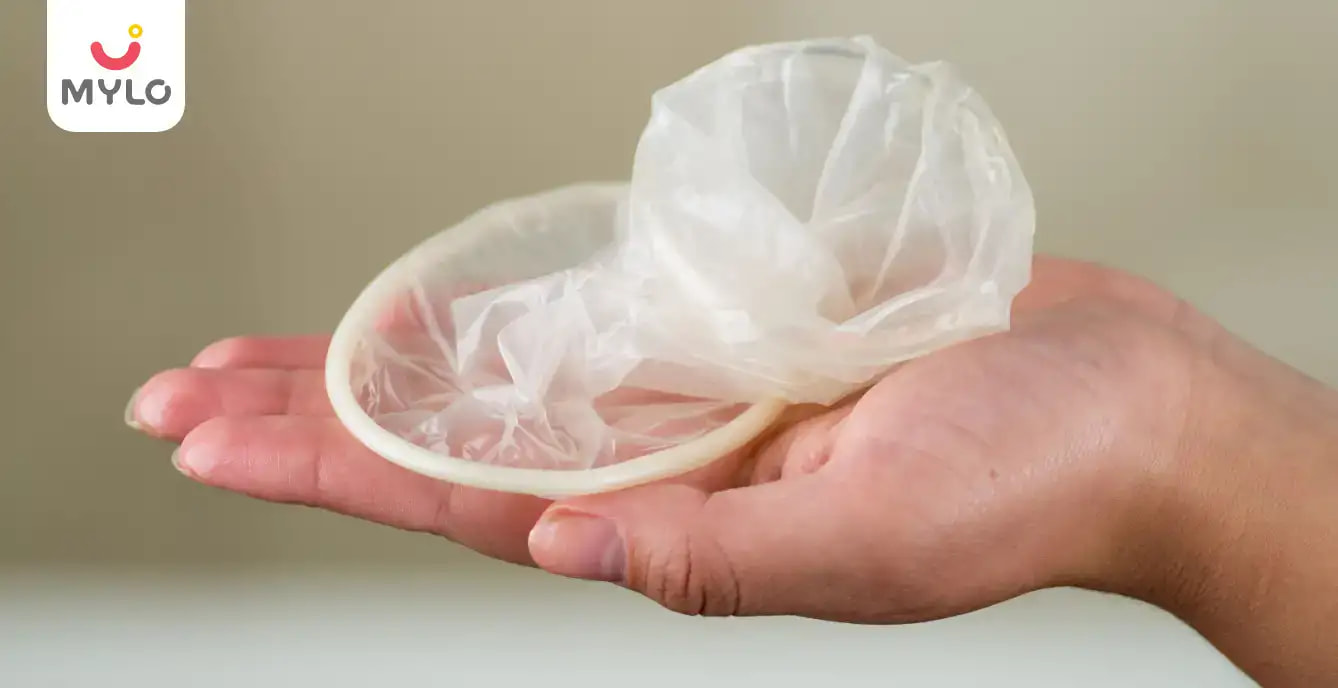Home

Contraceptive

The Ultimate Guide to Choosing Between Male and Female Condoms
In this Article

Contraceptive
The Ultimate Guide to Choosing Between Male and Female Condoms
Updated on 3 November 2023
When it comes to safe and responsible sexual practices, condoms have always been the go-to option. They provide a reliable barrier method to prevent unwanted pregnancies and protect against sexually transmitted infections (STIs). However, when it comes to choosing between male and female condoms, many individuals find themselves unsure of which option to go for.
In this comprehensive guide, we aim to shed light on the differences, advantages, and disadvantages of male vs female condoms, empowering you to make an informed decision.
What is the Difference Between Male and Female Condom?
Understanding the following differences can help individuals make an informed decision about which type of condom is best suited to their needs.
1. Design and Usage
Male condoms are typically made of latex or polyurethane and are worn over the penis. They provide a barrier between the penis and the vagina, preventing the exchange of bodily fluids.
On the other hand, female condoms are inserted into the vagina prior to intercourse. They have a flexible ring at one end that remains outside the vagina and covers the labia, while the other end sits inside the vagina, creating a barrier.
2. Protection
Both the condoms are highly effective at preventing sexually transmitted infections (STIs) and unintended pregnancies when used correctly.
However, male condoms have been extensively studied and have a slightly higher efficacy rate compared to female condoms. This is largely due to the fact that male condoms have been on the market for a longer time and have undergone more rigorous testing.
3. Sensation
One aspect that often comes up in discussions about these two condoms is the impact on sexual sensation. Some individuals report that male condoms can decrease sensitivity and pleasure due to the barrier they create.
On the other hand, female condoms are often praised for their ability to enhance pleasure, as they provide additional stimulation and can increase friction during intercourse.
4. Availability
Male condoms are widely available and can be found in pharmacies, convenience stores, and online. They are also often distributed for free at health clinics and educational institutions.
Female condoms, however, may be less readily available. They can be found in some stores and online, but their availability may vary depending on the region.
5. Cost
In terms of cost, male condoms are generally more affordable compared to female condoms. This is partly due to the fact that male condoms are mass-produced and have been around for a longer time, leading to economies of scale.
Female condoms, on the other hand, tend to be more expensive due to their lower demand and production volumes.
You may also like: How To Use Condoms To Avoid Pregnancy
Female Condom vs Male Condom: Advantages
While both male and female condoms serve the same purpose of preventing STIs and unintended pregnancies, there are specific advantages to using each type. Understanding these advantages can help individuals make an informed decision based on their personal preferences and needs.
Advantages of Male Condoms
1. Ease of Use
Male condoms are straightforward to use and require minimal preparation. They can be easily carried in a pocket or wallet, making them convenient for spontaneous encounters.
2. Protection
Male condoms provide a physical barrier that effectively prevents the exchange of bodily fluids, protecting against STIs and unintended pregnancies.
3. Variety
Male condoms come in a wide range of sizes, textures, and materials, allowing individuals to find the one that best suits their needs and preferences.
You may also like: What is Birth Control Patch?
Advantages of Female Condoms
1. Control
Female condoms give the wearer more control over their protection. They can be inserted prior to sexual activity, empowering individuals to take charge of their own safety.
2. Increased Sensation
Female condoms have been praised for their ability to enhance sexual pleasure. The external ring can stimulate the clitoris, while the internal pouch provides additional friction and stimulation.
3. Compatibility
Female condoms are compatible with oil-based lubricants, which can be more long-lasting and provide a smoother experience compared to water-based lubricants.
You may also like: The Ultimate Guide On How to Use Female Condom
Female Condom vs Male Condom: Disadvantages
While both these condoms have their advantages, it's important to also consider the disadvantages of each option. Being aware of these disadvantages can help individuals make a well-rounded decision and choose the option that aligns with their personal preferences and needs.
Male Condoms Disadvantages
1. Sensitivity
Some individuals report decreased sensitivity and pleasure when using male condoms due to the barrier they create.
2. Fit
Finding the right fit can be a challenge for some individuals. Ill-fitting condoms can be uncomfortable and may increase the risk of breakage.
3. Allergy
Male condoms are typically made of latex, which can cause allergic reactions in some individuals. However, non-latex alternatives are available for those with latex allergies.
Female Condoms Disadvantages
1. Insertion
Inserting a female condom can be more complex and may require practice to ensure proper placement.
2. Availability
Female condoms may be less readily available compared to male condoms, making them more difficult to obtain in certain areas.
3. Cost
Female condoms tend to be more expensive compared to male condoms, which can be a deterrent for some individuals.
You may also like: Where Can You Buy Female Condoms?
Factors to Consider When Choosing Between Male and Female Condoms
When deciding between condoms, it's essential to consider several factors to ensure the best choice for individual needs and preferences. By carefully evaluating these factors, individuals can make an informed decision and prioritize their sexual health.
1. Effectiveness
Evaluate the effectiveness of both the condoms in preventing STIs and unintended pregnancies. Consider the efficacy rates, reliability, and studies supporting their effectiveness.
2. Comfort
Assess the comfort level of both types of condoms. Consider factors such as fit, sensitivity, and the overall experience during intercourse.
3. Convenience
Consider the convenience of obtaining and using the condoms. Evaluate availability, ease of use, and portability.
4. Cost
Compare the cost of both the condoms. Consider the long-term affordability and whether the cost is a significant factor in decision-making.
5. Personal Preference
Ultimately, personal preference plays a crucial role in selecting the right condom. Consider factors such as sensation, control, and compatibility with lubricants.
You may also like: How to Avoid Pregnancy Naturally: The Ultimate Guide to Natural Family Planning
FAQs
1. What is the difference between male and female condom effectiveness?
Male condoms have been extensively studied, and their efficacy rates are well-documented. Female condoms, while also effective, may have slightly lower efficacy rates due to their lower demand and production volumes.
2. What are some common female condom disadvantages?
Some common disadvantages of female condoms include the complexity of insertion, limited availability in certain areas, and higher cost compared to male condoms.
The Bottomline
When deciding between male and female condoms, it's important to consider the differences, advantages, disadvantages, and various factors that come into play. Both these condoms are effective in preventing STIs and unintended pregnancies, but personal preference, comfort, convenience, and cost should all be taken into account. Before making a final decision, it's advisable to consult with a healthcare professional for guidance tailored to your specific needs and concerns.



Written by
Priyanka Verma
Priyanka is an experienced editor & content writer with great attention to detail. Mother to an 11-year-old, she's a ski
Read MoreGet baby's diet chart, and growth tips

Related Articles
Related Questions
Influenza and boostrix injection kisiko laga hai kya 8 month pregnancy me and q lagta hai ye plz reply me

Hai.... My last period was in feb 24. I tested in 40 th day morning 3:30 .. That is faint line .. I conculed mylo thz app also.... And I asked tha dr wait for 3 to 5 days ... Im also waiting ... Then I test today 4:15 test is sooooo faint ... And I feel in ma body no pregnancy symptoms. What can I do .

Baby kicks KB Marta hai Plz tell mi

PCOD kya hota hai

How to detect pcos

RECENTLY PUBLISHED ARTICLES
our most recent articles

Diet & Nutrition
গর্ভাবস্থায় আলুবোখরা: উপকারিতা ও ঝুঁকি | Prunes During Pregnancy: Benefits & Risks in Bengali

Diet & Nutrition
গর্ভাবস্থায় হিং | ঝুঁকি, সুবিধা এবং অন্যান্য চিকিৎসা | Hing During Pregnancy | Risks, Benefits & Other Treatments in Bengali

Women Specific Issues
স্তনের উপর সাদা দাগ: লক্ষণ, কারণ এবং চিকিৎসা | White Spots on Nipple: Causes, Symptoms, and Treatments in Bengali

Diet & Nutrition
গর্ভাবস্থায় পোহা: উপকারিতা, ধরণ এবং রেসিপি | Poha During Pregnancy: Benefits, Types & Recipes in Bengali

Diet & Nutrition
গর্ভাবস্থায় মাছ: উপকারিতা এবং ঝুঁকি | Fish In Pregnancy: Benefits and Risks in Bengali

Diet & Nutrition
গর্ভাবস্থায় রেড ওয়াইন: পার্শ্ব প্রতিক্রিয়া এবং নির্দেশিকা | Red Wine During Pregnancy: Side Effects & Guidelines in Bengali
- ইনার থাই চ্যাফিং: কারণ, উপসর্গ এবং চিকিৎসা | Inner Thigh Chafing: Causes, Symptoms & Treatment in Bengali
- গর্ভাবস্থায় ব্রাউন রাইস: উপকারিতা ও সতর্কতা | Brown Rice During Pregnancy: Benefits & Precautions in Bengali
- Velamentous Cord Insertion - Precautions, Results & Safety
- Unlock the Secret to Flawless Skin: 7 Must-Have Qualities in a Face Serum
- Unlock the Secret to Radiant Skin: How Vitamin C Serum Can Transform Your Complexion
- Gender No Bar: 10 Reasons Why Everyone Needs a Body Lotion
- Unlock the Secret to Radiant Skin How to Choose the Perfect Body Lotion for Your Skin Type
- Top 10 Reasons to Apply a Body Lotion After Every Bath
- Communication in Toddlers: Milestones & Activities
- How to Improve Vocabulary for Toddlers?
- A Comprehensive Guide to Understanding Placenta Accreta
- Vulvovaginitis in Toddlers Causes, Symptoms and Treatment
- A Comprehensive Guide to Understanding Cerebral Palsy in Children
- Bitter Taste in Mouth During Pregnancy: Understanding the Causes and Remedies


AWARDS AND RECOGNITION

Mylo wins Forbes D2C Disruptor award

Mylo wins The Economic Times Promising Brands 2022
AS SEEN IN
















- Mylo Care: Effective and science-backed personal care and wellness solutions for a joyful you.
- Mylo Baby: Science-backed, gentle and effective personal care & hygiene range for your little one.
- Mylo Community: Trusted and empathetic community of 10mn+ parents and experts.
Product Categories
baby carrier | baby soap | baby wipes | stretch marks cream | baby cream | baby shampoo | baby massage oil | baby hair oil | stretch marks oil | baby body wash | baby powder | baby lotion | diaper rash cream | newborn diapers | teether | baby kajal | baby diapers | cloth diapers |








